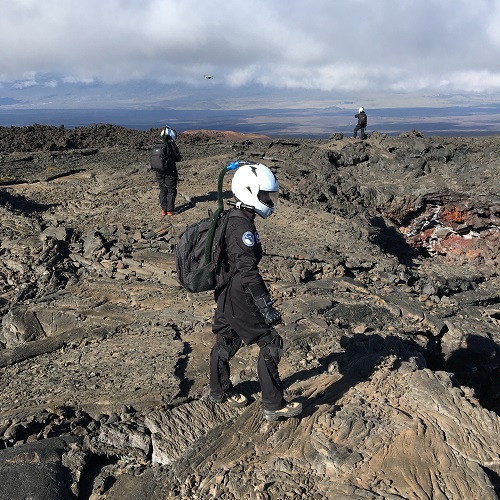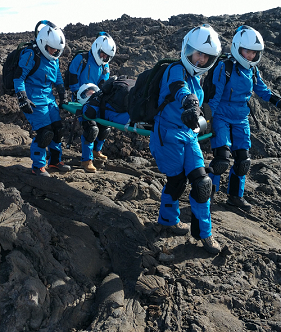The Second EuroMoonMars IMA at HI-SEA Field Campaign: An Overview of The EMMIHS-II Analog Mission to the Moon
- 1International Moonbase Alliance, United States of America (musilova@moonbasealliance.com)
- 2Institute of Robotics and Cybernetics, Faculty of Electrical Engineering and Information Technology STU in Bratislava, Slovakia
- 3Slovak Organisation for Space Activities (SOSA), Bratislava, Slovakia
- 4Applied physics, Hague University of Applied Sciences, Delft
- 5ESA ESTEC, Noordwijk & ILEWG
- 6Vrije Universiteit Amsterdam
Introduction:
Simulated missions to the Moon and Mars have been taking place at the analog research station HI-SEAS (Hawaii - Space Exploration Analog and Simulation) since 2013. The so-called Martian and lunar habitat, HI-SEAS, is located in Hawaii and its research projects are run by the International Moonbase Alliance (IMA) [1]. Numerous aspects of space missions are simulated in order to make them be as realistic as possible, including time delays in communication, emergency procedures and performing relevant research.
In 2019, the EuroMoonMars campaign was launched at HI-SEAS, bringing together researchers from the European Space Agency (ESA), IMA, the International Lunar Exploration Working Group (ILEWG), VU Amsterdam and many other international organizations [2,3]. The campaign aims to increase awareness about the research and technology testing that can be performed in analog environments, in order to help humans become multi-planetary species. Furthermore, the research and technological experiments conducted at HI-SEAS are going to be used to help build a Moon base in Hawaii, and ultimately to create an actual Moonbase on the Moon, as part of IMA’s primary goals [3,4,5].
The EMMIHS II mission research:
EMMIHS-II was the second campaign organized by the EuroMoonMars group, taking place from December 8th-22nd, 2019. When the crew left the HI-SEAS habitat, they wore analog space-suits and went through full extravehicular activity (EVA) protocols to perform their research in the simulated lunar terrain. The crew was supported by a Mission Control Center (MCC) based in Hawaii and a Remote Support team based at EuroMoonMars ESA/ESTEC in the Netherlands [2,3,4,5]. The main research themes of the EMMIHS-II campaign were as follows:
Engineering research: Crew engineers are responsible for numerous tasks to ensure nominal operations and the maintenance of the EVA and habitat equipment. They prepare a daily Engineering Report for the MCC, which includes the status of the equipment, recommendations for improvements and any requests for support. They are also responsible for supporting other crew members’ research projects if needed. At least two crewmembers should serve as crew engineers with strong analytical, troubleshooting and hands-on technical skills.
Lava tubes as habitats: Detailed investigations were performed of the lava tubes in the vicinity of the HI-SEAS habitat [Figure 1]. They were subsequently compared to lava tubes on the Moon, with the intension of creating an environmental guideline for the architectural lunar habitat development in lava tubes.

Figure 1. EMMIHS-II crew exploring lava tubes with drone in-field recognition.
Nutrition for astronauts: Dietary needs and the health of each crew member was monitored and the crew followed a pre-prepared personal menu based on their intolerances and daily activities. Various digestive problems were identified. In order to avoid this on future missions, the dietary intake of vegetable fiber for each individual could be estimated before the mission start in order to adapt the fruit and vegetable rations individually. It was found that freeze-dried food did not contribute to the emotional well-being of the astronauts.
Growing fresh food using analog lunar soil: The fast-growing garden cress was sown in analog lunar soil collected by the HI-SEAS habitat. Coarse soil mixed with a small amount of compost is sufficient for germination and plant growth in the first stage of plant development. In the future, such crops could be grown more extensively in greenhouses on Mars or the Moon as sources of nutrients and oxygen for the crew, as well as to reduce compost and fertilizer payloads.
3D additive manufacturing: Dual extrusion 3D printing technologies were used to assess how additive manufacturing can improve livability in a space habitat. For instance, personal items for the analog astronauts’ leisure time activities and engineering tools were printed. Their effects on the crew were evaluated in a comparative survey.
Privacy and color during space missions: Comparative daily surveys were undertaken by the crew to evaluate the effects of different types of privacy and color deprivation situations. The findings will serve as a basis for future architectural design concepts in extra-terrestrial habitats.
Emergency medical simulation: A casualty evacuation (CASEVAC) exercise was performed to execute a mock injury while 1) maintaining simulation conditions as if on an EVA, or 2) “breaking simulation” to allow the crew to train for a real world situation. The in-simulation injury scenario was executed in the spirit of a robust approach to understanding the unexpected problems which may arise during space exploration [Figure 2].

Figure 2. EMMIHS-II crewmembers are performing a CASEVAC (Casualty Evacuation) drill during an EVA.
Outreach: Outreach and educational activities were performed in order to reach out to and inspire as many young people as possible to be interested in STEM subjects. Some of these projects involved installing a Moon gallery at the HI-SEAS habitat, creating videos for school children during the missions, and performing research experiments designed by students all around the world.
Future plans:
Future missions at HI-SEAS include more EuroMoonMars IMA HI-SEAS (EMMIHS) missions, collaborative missions with ESA, NASA, universities worldwide and with companies. These missions will continue to contribute to the development of technologies to lay a foundation for creating a sustainable settlement on the Moon.
Acknowledgments:
First, we would like to thank the EMMIHS II crew (M. Musilova, S Kerber, A Wanske, J D’Angelo, A P Castro de Paula Nunes, C R Pouwels), the Mission Control from HI-SEAS (Andrew Cox et al.), ILEWG’s EuroMoonMars Manager B. Foing, and the Remote Control team (A. Jageli, J. Preusterink, A. Beniest, A. Sitnikova, et al.). We would also like to thank our sponsors and their generous support: Ruag Space, Capable BV, Kurtz Ersa, dB Matik AG, Tridonic GmbH CoKG, and the Brazilian Space Agency (AEB)
References:
[1] https://hi-seas.org
[2] Musilova M, Rogers H, Foing B, Sirikan N. et al. (2019), EMM IMA HI-SEAS campaign February 2019, EPSC-DPS2019-1152
[3] Sirikan, N., Foing, B., Musilova, M., et al. (2019). EuroMoonMars IMA HI-SEAS 2019 Campaign: An Engineering Perspective on a Moon Base, IAC, 21-25 October 2019. Washington DC, USA.
[4] Musilova, Michaela, Henk Rogers, and Bernard Foing. “Analogue research performed at the HI-SEAS research station in Hawaii.” Geophysical Research Abstracts. Vol. 21. 2019.
[5] https://moonbasealliance.com/
How to cite: Musilova, M., Nunes, A., Kerber, S., Pouwels, C., Wanske, A., D'Angelo, J., Foing, B., and Rogers, H.: The Second EuroMoonMars IMA at HI-SEA Field Campaign: An Overview of The EMMIHS-II Analog Mission to the Moon , Europlanet Science Congress 2020, online, 21 September–9 Oct 2020, EPSC2020-1020, https://doi.org/10.5194/epsc2020-1020, 2020

